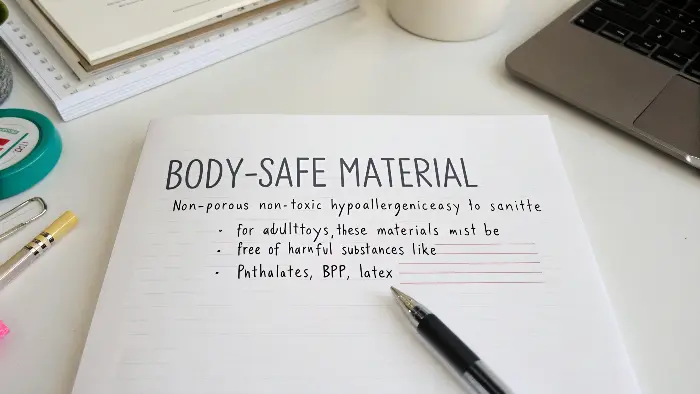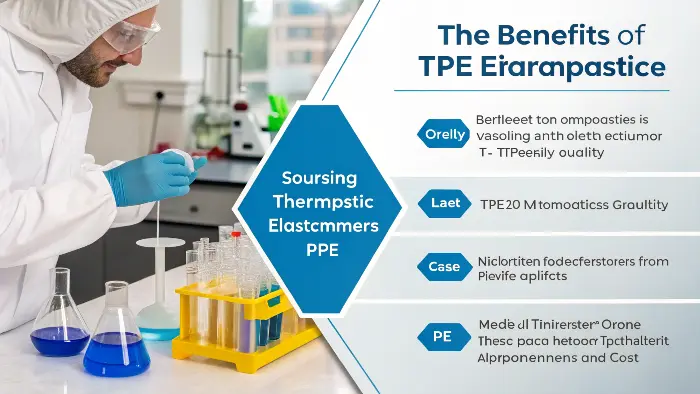Choosing the right material for your adult products feels overwhelming. A bad choice can lead to customer complaints, safety scares, and serious damage to your brand’s reputation. Understanding the real safety differences between TPE and silicone is the first step to protecting your business and your customers.
For overall safety, platinum-cured silicone is the superior choice. It is non-porous, hypoallergenic, body-safe, and extremely durable. While high-quality TPE can be safe, it is porous and its quality varies significantly between suppliers. This makes silicone a more reliable and lower-risk material for adult product brands concerned with safety and reputation.
![]()
Making the right material choice is one of the most important decisions you’ll make as a brand owner. It affects everything from customer satisfaction to your legal liability. This isn’t just about feel or color; it’s about the fundamental safety of the products that carry your name. Let’s dive deeper into what these differences mean for you and your manufacturing process, so you can build your product line with confidence.
What makes a material "body-safe" in the first place?
The term "body-safe" is used so often it can lose its meaning. You worry that a material you thought was safe might contain hidden chemicals, leading to customer harm and legal nightmares. You need to know the clear, non-negotiable criteria for a truly safe material.
A genuinely body-safe material is non-porous, non-toxic, hypoallergenic, and simple to sanitize. Specifically for adult toys, this means it must be free of harmful substances like phthalates, BPA, and latex. The material should not absorb bacteria or break down with proper use and cleaning, ensuring user safety.

When I started PrivyPlay, my goal was to create products people could trust completely. That trust starts at the molecular level. A material’s properties determine its safety profile, and as a brand owner, you need to be an expert in these basics. It protects your customers and, ultimately, your business. Let’s break down the key elements that define a material as truly safe for intimate use.
Porosity: The Hidden Danger
Porosity refers to whether a material has tiny, microscopic pores on its surface.
- Porous Materials (like TPE): These pores can trap bacteria, mold, and fungi. Even with thorough cleaning, it can be impossible to completely sanitize the material. Over time, these trapped microbes can multiply, creating a risk of infections or irritation for the user. This is the single biggest safety concern with lower-grade TPE.
- Non-Porous Materials (like Silicone): High-quality silicone has a smooth, solid surface with no pores. Bacteria have nowhere to hide. This means it can be cleaned effectively with simple soap and water or even boiled for complete sterilization, making it inherently more hygienic.
Chemical Composition: What’s Inside Matters
The safety of a material is also defined by what it doesn’t contain. Many plastics and rubbers are softened with chemicals that can be harmful.
- Phthalates: These are chemical plasticizers often used to make plastics like PVC soft and flexible. They are known endocrine disruptors and have been linked to serious health issues. Any material used for adult products must be certified phthalate-free.
- BPA, Latex, and Heavy Metals: These are other common substances that can cause allergic reactions or have toxic effects. Body-safe materials must be free from these as well. Always demand documentation from your supplier that proves their materials pass tests for these harmful substances, like those required by European REACH regulations.
Is silicone truly the gold standard for safety?
You hear everywhere that silicone is the best, but you wonder if it’s just marketing hype. With so many suppliers offering "silicone" products at wildly different prices, you worry that a cheaper version could contain unsafe fillers. You need to know what makes one type of silicone safer than another.
Yes, 100% pure, platinum-cured medical-grade silicone is the undisputed gold standard for safety in adult products. Its non-porous and hypoallergenic nature prevents bacterial growth and allergic reactions. The key is to ensure you are not buying a cheaper, tin-cured version or a blend diluted with unsafe fillers.
![]()
Not all materials that look and feel like silicone are created equal. The difference in safety and quality comes down to the curing process and the purity of the material itself. As a manufacturer, understanding this distinction is critical for sourcing products that are genuinely safe. It’s a key part of my philosophy at PrivyPlay, and it’s something I discuss with every potential partner.
Platinum-Cured vs. Tin-Cured Silicone
The "curing" process is what turns liquid silicone into the soft, solid rubbery material we know. The catalyst used in this process has a huge impact on the final product’s safety.
- Platinum-Cured Silicone: This is the highest grade. It uses a platinum catalyst, which results in the purest, cleanest final product with no toxic byproducts. It’s the same type of silicone used for medical implants and baby bottle nipples. It is incredibly durable, has no odor, and can be boiled for sterilization without degrading. This is the only type of silicone we use at PrivyPlay.
- Tin-Cured Silicone: This method uses a tin-based catalyst. It’s much cheaper, but the final product is not as pure or stable. Over time, tin-cured silicone can become brittle and may leach chemicals. It is not considered body-safe and should never be used for products that have intimate contact with the body.
The Problem with Fillers
To cut costs, some factories mix silicone with cheaper, unsafe materials or "fillers." This creates a product that feels like silicone but lacks its safety features. I remember visiting a potential supplier years ago who showed me a beautiful product. But when I performed a simple "stretch test"—pulling the material hard—I saw white stress lines appear. This is a tell-tale sign of fillers. Pure silicone stretches without changing color. This experience reinforced why we perform rigorous testing on all our raw materials. A compromised material puts the end-user at risk and is a ticking time bomb for any brand.
When is TPE a safe and smart choice for my products?
TPE is significantly less expensive than silicone, and that’s incredibly appealing for your bottom line. But you’re hesitant, worried that choosing TPE means sacrificing safety and your brand’s quality reputation. You need to know if there’s a way to use TPE without cutting corners.
TPE (Thermoplastic Elastomer) is a safe and strategic choice only when you source a high-quality, medical-grade version from a transparent and reputable manufacturer. It must be certified phthalate-free. TPE excels for products that require an extremely soft, stretchy, or lifelike texture that silicone can’t always replicate.

TPE has its place in the market, and dismissing it entirely would be a mistake. It offers a unique, jell-like feel that many customers love, and its lower cost can help you offer products at a more accessible price point. The challenge isn’t the material itself, but the vast range of quality within the TPE category. Your job as a brand owner is to navigate this spectrum carefully.
Understanding the TPE Quality Spectrum
Unlike silicone, "TPE" is not a single material. It’s a broad class of copolymers, essentially a blend of plastic and rubber. This is why the quality can vary so much.
- Low-Grade TPE: This is the cheap, often sticky or oily material found in novelty items. It is highly porous, may have a chemical smell, and is often made with phthalates. It degrades quickly and is not body-safe.
- High-Grade, Medical TPE: At the other end of the spectrum is medical-grade TPE. It is engineered to be phthalate-free, less porous, and more durable. While still more porous than silicone, its surface can be made much smoother through better manufacturing techniques. This is the only type of TPE a reputable brand should consider.
Critical Safety Rule: Lubricant Compatibility
This is a non-negotiable safety issue for any product made from TPE. Because TPE is a thermoplastic elastomer, certain chemicals will break it down at a molecular level, making it sticky, warped, and unsafe. You must provide clear instructions to your customers.
| Lubricant Type | Silicone Toy Compatibility | TPE Toy Compatibility |
|---|---|---|
| Water-Based | ✅ Safe | ✅ Safe |
| Silicone-Based | ❌ Damaging | ❌ Damaging |
| Oil-Based (e.g., coconut oil, massage oil) | ✅ Safe | ❌ Damaging |
Failure to educate your customers on this point can lead to damaged products and very unhappy customers. It’s a liability issue where clear communication is your best defense.
How can I verify the safety of materials from my supplier?
You’re talking to a potential supplier, and they promise their materials are "100% body-safe." But you know you can’t just take their word for it. Getting this wrong could lead to a product recall, lawsuits, and the destruction of the brand you’ve worked so hard to build.
To verify material safety, you must demand and review documentation. Start by requesting a Material Safety Data Sheet (MSDS) and third-party lab test reports for compliance with regulations like REACH or Prop 65. Always order samples for physical inspection before commissioning your own independent lab tests on a full production batch.

Trust, but verify. This is the mantra every sourcing manager and brand owner should live by. Building a relationship with a factory is important, but that trust must be earned through transparency and proof. At PrivyPlay, we provide this documentation proactively because we know it’s the foundation of a good partnership. Here are the steps you should take with any potential supplier.
Step 1: Request the Essential Paperwork
Don’t even start a serious conversation without asking for documentation.
- Material Safety Data Sheet (MSDS): This document outlines the chemical properties and potential hazards of a material. It’s the first piece of evidence you should review.
- Third-Party Lab Reports: An MSDS from the material producer is good, but an independent test report is better. These reports should verify that the final product is free from phthalates, heavy metals, and other toxins as required by safety standards in your target market (e.g., REACH in the EU, Prop 65 in California).
Step 2: Conduct Physical Sample Tests
Once you have samples in hand, you can perform some basic at-home tests.
- The Smell Test: Low-quality TPE or tin-cured silicone often has a strong chemical odor. High-quality, platinum-cured silicone and medical-grade TPE should be virtually odorless.
- The Stretch Test: As I mentioned before, stretch the material firmly. If you see white lines appear in the material, it’s a sign it has been mixed with cheap fillers.
- The Flame Test (For Silicone Only, Use Caution): When exposed to a flame, pure silicone will ash, but it won’t produce a black, sooty smoke or melt into a gooey mess. Impure silicone will. This is a destructive test, so only do it on a sample you’re willing to sacrifice.
Step 3: Commission Your Own Independent Tests
For complete peace of mind, especially before a large production run, send a sample from your initial batch to a certified lab yourself. This is the ultimate verification. It ensures that the material used in mass production is the exact same high-quality material you approved in the sample stage. It’s an investment in your brand’s security.
Conclusion
Ultimately, pure silicone remains the safest, most reliable choice for adult products. However, high-quality TPE is a viable, body-safe option when sourced diligently from a trustworthy manufacturer. Your brand’s reputation is built on safety, so never compromise on material verification and quality control.
